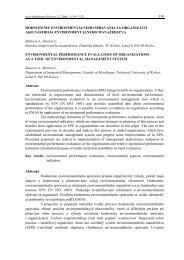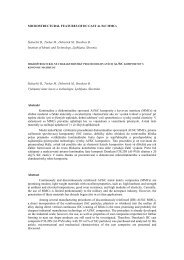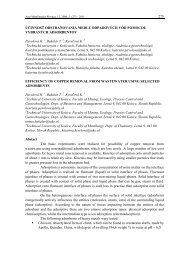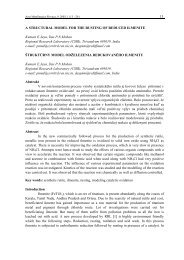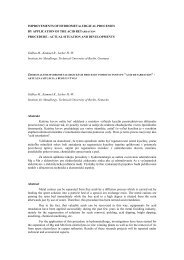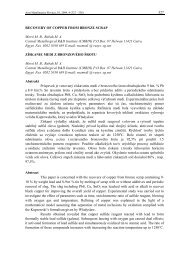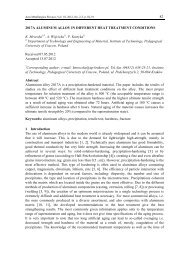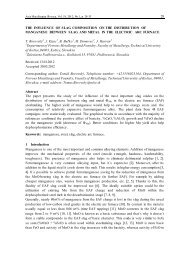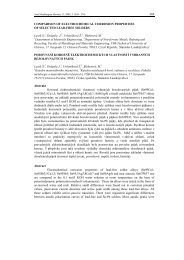199 mathematical modeling of mold-filling and solidification - Acta ...
199 mathematical modeling of mold-filling and solidification - Acta ...
199 mathematical modeling of mold-filling and solidification - Acta ...
You also want an ePaper? Increase the reach of your titles
YUMPU automatically turns print PDFs into web optimized ePapers that Google loves.
<strong>Acta</strong> Metallurgica Slovaca, 15, 2009, 3 (<strong>199</strong> - 207) 201<br />
where v r =(u, v, w) is the velocity.<br />
b) The momentum conservation equation (Navier–Stokes) can be expressed as [5]:<br />
r<br />
⎧∂<br />
v r r⎫<br />
2 r r<br />
ρ ⎨ + v ∇. v⎬<br />
= -∇ P + µ ∇ v + ρg<br />
⎩ ∂ t ⎭<br />
(2)<br />
where, ρ is the density assumed to be constant, P r is the pressure, µ is the dynamic viscosity<br />
constant <strong>and</strong> g r is the gravity vector.<br />
c) The energy conservation equation for the liquid region is given by [6]:<br />
⎛ ∂T<br />
r ⎞ 2 L ∂φ<br />
ρc⎜<br />
+ v.<br />
∇T<br />
⎟ = k∇<br />
T −<br />
⎝ ∂t<br />
⎠ c ∂t<br />
(3)<br />
where c is the specific heat, k is the thermal conductivity, L is the latent heat, φ is the<br />
volumetric liquid fraction <strong>and</strong> T is the temperature.<br />
When the molten metal starts to fill the <strong>mold</strong>, the turbulence phenomenon begins.<br />
Turbulence means that the instantaneous velocity is fluctuating at every point in the flow field.<br />
Many <strong>mathematical</strong> models existing in the literature are used to simulate the turbulence,, i.e., a<br />
total <strong>of</strong> eight turbulence models are available [5; 7, 8; 9; 10; 11; 12]. These models acronyms<br />
<strong>and</strong> names are: St<strong>and</strong>ard k-ε Model, Zero Equation Model, RNG - (Re-normalized Group<br />
Model), NKE - (New κ-ε Model), GIR, SZL, St<strong>and</strong>ard k-ω Model, SST. The κ-ε model <strong>and</strong> its<br />
extensions entail solving partial differential equations for the turbulent kinetics energy κ <strong>and</strong> its<br />
dissipation rate ε.<br />
d) The turbulent kinetics energy equation for NKE - (New κ-ε Model) is given by:<br />
∂(<br />
ρκ ) ∂(<br />
ρuκ)<br />
∂(<br />
ρvκ<br />
) ∂(<br />
ρwκ)<br />
∂ ⎛ µ<br />
+ + + = ⎜ t<br />
∂t<br />
∂x<br />
∂y<br />
∂z<br />
∂x<br />
⎝ σ k<br />
C βµ ⎛ ∂T<br />
∂T<br />
∂T<br />
⎞<br />
− ρε +<br />
4 t<br />
⎜ g x + g y + g z<br />
⎟<br />
σ t ⎝ ∂x<br />
∂y<br />
∂z<br />
⎠<br />
∂κ<br />
⎞ ∂ ⎛ µ<br />
⎟ + ⎜ t<br />
∂x<br />
∂<br />
⎠ y ⎝ σ k<br />
∂κ<br />
⎞ ∂ ⎛ µ<br />
⎟ + ⎜ t<br />
∂y<br />
∂<br />
⎠ z ⎝ σ k<br />
∂κ<br />
⎞<br />
⎟<br />
+ µ tΦ<br />
∂z<br />
⎠<br />
(4)<br />
The viscous dissipation term in tensor notation is:<br />
⎛<br />
⎜ ∂u<br />
Φ = µ i<br />
⎜<br />
⎝<br />
∂xk<br />
∂u<br />
⎞<br />
k ∂u<br />
+ ⎟ i<br />
∂x<br />
j ⎟<br />
⎠<br />
∂xk<br />
where σ t , is the turbulent Pr<strong>and</strong>tl (Schmidt) number; g x , g y <strong>and</strong> g z , are the components <strong>of</strong><br />
acceleration due to gravity <strong>and</strong> u i , the magnitude <strong>of</strong> the velocity vector.<br />
The turbulent viscosity is calculated as a function <strong>of</strong> the turbulent kinetics energy<br />
parameter, κ, <strong>and</strong> its dissipation rate ε, that is:<br />
2<br />
κ<br />
µ t = ρCµ<br />
ε<br />
where, C µ , is the turbulent constant; κ is the turbulent kinetics energy parameter <strong>and</strong> ε is the<br />
turbulent kinetics energy dissipation rate.



